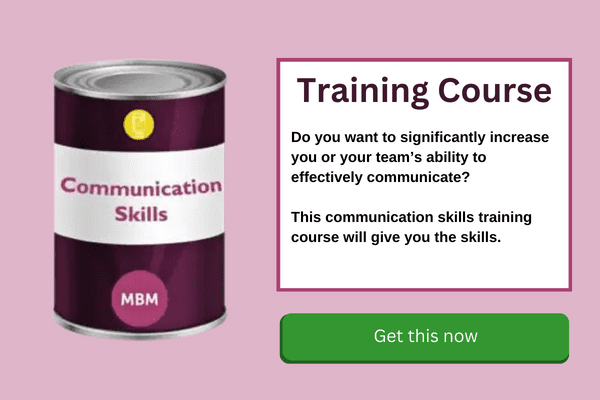Put Speaking Assertively and Asserting Yourself Top of Your To-Do List
Assertive language at work often gets mistaken for aggression. That’s particularly true if you’ve previously been quite passive. But they’re very different.
This article considers how enhancing your assertiveness can transform your work life. And power up the personal side.
Three essential soft skills make awkward situations more manageable, and everyday life more fulfilled. Assertive language: that’s the words. How to speak assertively takes in the delivery. And how to assert yourself, that’s the performance. You’ll hear how assertiveness can help smooth workplace diversity problems. And don’t miss our Aussie midwives’ “3 C’s” assertiveness tips and the homework exercises at the end.

Address Your Assertiveness and Achieve Your Goals
Assertiveness skills are available to everyone. But we don’t all use them properly. At work, we want to achieve our goals but also be accepted and understood. And that takes assertiveness.
Passive, Aggressive, Assertive: What’s the Difference?
As we mentioned, these terms get confused. Edith Eva Eger came up with this explanation: “To be passive is to let others decide for you. Being aggressive means deciding for others. And being assertive is to decide for yourself, and trust you are enough.”
There’s a place for politeness. But sometimes, in business or elsewhere, you have to be assertive. You can be assertive without being rude. Listen to conversations around you and make yourself aware of the difference between assertive, aggressive and passive.
Being Assertive Can be so Very ‘HARD’ to do
Sticky Learning ® is 7 times more effective than 1-day training courses. Plus, you will get a Chain of Evidence proving your Return on Investment. Discover soft skills training that changes behaviours long term.

What is Assertive Language?

Assertive language communicates your thoughts, feelings and opinions so others understand them clearly. But – this is the important point – it does so without dismissing or denying other people’s thoughts, feelings and opinions.
An American healthcare provider’s patient handout puts it memorably. Assertiveness is the ability to express thoughts and feelings the ‘HARD’ way:
- Honest
- Appropriate
- Respectful
- Direct
Respect is crucial because the other individuals are also important. Communicating clearly helps minimise conflict and control anger.
What is an Assertive Personality?
Assertive individuals are self-assured, even-tempered and resistant to stress. But there’s a downside. Assertive people sometimes presume they are entitled to do much more than others would allow or tolerate. If they get overconfident, they may come to believe their confidence overrides what other people want.
What are Some Examples of Assertive Communication?
- Saying NO when justified, without feeling guilty.
- Expressing your feelings authentically.
- Asking for what you want directly.
- Being able to change your mind.
- Negotiating compromises when conflicts occur.
How is Assertive Language Used?
Here are some classic things you might say in assertive communication:
- Could you explain the reasoning behind your decision, so I can understand what you’re doing?
- (To a co-worker) We’ve done all this, now pull your weight and do your share.
- Please don’t interrupt, give the other people a chance to speak as well.
- I completely understand what you’re saying, but I have to disagree.
Which Emotional Traits Do You Need to Act Assertively?
- A good level of self-esteem: accept yourself and be self-aware.
- Confidence: preparedness to tackle the problem, without fear of conflict.
- Respect for others and their opinions.
- Emotional strength and courage.

What are the Hallmarks of an Assertive Person?
- Ability to stand up for yourself: take responsibility for the consequences of your choices.
- Understanding yourself: knowing your boundaries, what you like and don’t like.
- Respecting others’ opinions: not feeling it necessary to insult or degrade them if they disagree.
- Having the ability to validate other people’s feelings: accepting their position, instead of minimising their experience if you don’t think the same way.
- Being a good listener: having good eye contact, not interrupting, and reflecting back to make sure you’ve understood.
- Working to solve problems and compromise: showing the other person you’ve heard their needs and your solution considers them.
What Communication Skills do Assertive Leaders Need?
- Ability to explain issues clearly, concisely, precisely.
- Be open, honest and empathetic.
- Communicate correctly – distinguish between facts and opinions.
- Decision making.
- Take an interest in other people’s point of view.
- Lead by example – if you won’t do it, they won’t.
- Acknowledge that others have rights too.
IN CASE OF FIRE, BREAK GLASS!
Here are some assertiveness techniques you may find helpful:

#1 Fogging
This strategy comes in useful if people are being manipulative or aggressive. Instead of reacting and arguing back, fogging gives a minimal, calm response. Placate them, without being defensive. And don’t agree to unreasonable demands.
Fogging means agreeing with the truth in the other person’s statements, even if critical of you. But by not being defensive or argumentative, the other person will stop. That’s because they’re not having the desired effect. When the atmosphere becomes less heated, you can discuss things more calmly.
#2 The Stuck Record
This employs a key assertiveness skill, calm persistence. Repeating what you want, time and time again. Do this without raising your voice, becoming angry, irritated or drawn into side issues. The trick is to stay calm, be clear about what you want. Stick to the point and don’t give up. Only accept a compromise if you’re happy with that outcome.
The actual words you use are important too.
#3 Assertive Sentences
An assertive sentence makes a statement or assertion. By all means change it later, as you reflect on your situation and new facts occur to you. But keep it as clear as you can.
#4 Positive Enquiry
This is a simple technique for handling positive comments such as praise and compliments. You might be unsure how to respond, hence it’s an assertiveness technique. To react appropriately to a compliment, try asking what they liked in particular. Engage them.
#5 Negative Enquiry
The flipside of positive enquiry, this means admitting something has happened and inviting their opinion. It’s better than getting aggressive or angry in response to criticism, and it kick-starts restoring the relationship.
Which Approach to Use – and When?
This is a judgement call. Whether you’re right, or you know you’re in the wrong, it’s best to be open and honest. If it’s your fault, fogging and the ‘stuck record’ may escalate a situation when assertiveness could have resolved it. This comes back to what we said at the start about assertiveness making awkward situations more manageable.
Ultimately, how you practise assertiveness in particular situations, is similar to how you stay calm when faced with stressors. You can’t control what happens to create situations. But you can do plenty to control how you react and handle yourself.
This Stuff Really Works
So focus on your self-awareness. Think about your responses and how you behave when you communicate with others. Practising making yourself more assertive, and you’ll find your communication and other interpersonal interactions become more positive.
How Can I Make My Language More Assertive?
- Be definite. Instead of ‘modal’ verbs like ‘could’ and ‘should,’ say ‘I will.’ And ‘I want,’ instead of ‘I need.’
- Use ‘I’ statements. I believe, I want, I feel, I need, I’m more than sure, I’m certain.
- Avoid words that can undermine you, like ‘sorry.’ This tells the other person you’re not confident and gives them your power. And ‘just’ suggests what you’ve got to say isn’t that important.
- Stick to your guns. Don’t let pushy people make you back down. If someone insists, keep repeating what you want, believe, will and won’t do.
- ‘Because’ is a powerful game-changer. If you give strong reasons and say them with determination, no-one will be upset you gave a negative answer.
By the way, this last tip comes from the New South Wales Nurses and Midwives Association. You can read their 3 C’s of assertiveness at the end, along with some self-help exercises.
Use the Assertiveness Phrasebook
If assertive language feels like a foreign country, don’t worry. It just takes practice. Meanwhile here are some useful phrases to help you become a more assertive communicator:
- Let’s stick to the agenda.
- Let me get straight to the point.
- My point is…
- The bottom line is…
- I would appreciate it if…
- I’m interested in…
- I’m curious about…
- We’re running behind schedule, let’s try and stay on track.
So, you’ve covered all the ground you need to. And now you’ve been through everything and you want to close the conversation. Try these phrases:
- Just no.
- Thanks, but I’m really not interested.
- Thanks but no thanks.
- No thank you.
- Thanks very much, we’re done.
Sorry, I Just Don’t Feel Comfortable With This!
Psychologists believe we can learn the ability to speak and act assertively. This is so we can act in our own best interest. Ultimately we should be able to:
- Stand up for ourselves without undue anxiety.
- Express honest feelings comfortably.
- Exercise our own rights without denying the rights of others.
If you’re having serious difficulty being assertive, it may be a sign that you have other problems, including low self-esteem, anxiety and depression.
Some danger signs of “un-assertiveness” are:
- Finding it difficult to stand up for your rights or put across your point of view.
- Behaving passively and complying with the wishes of others.
- Responding aggressively and failing to consider the needs of others.
We all have off days. And stuff happens in our lives to weigh us down. But if your assertiveness difficulties continue and you’re worried, you may want to get help from your GP. Or talk to a sympathetic colleague or your HR department.
Things Can Only Get Better

Assertiveness Training Explained
After reading this far, you may decide you need some training in this stuff. Assertiveness training offers skills that are valuable for both our personal and professional lives. They help us find ways to:
- Become our own master and avoid being trampled on.
- Get what we want without being aggressive.
- Reduce stress and gain clarity in interactions by learning what to accept, and when to say no.
- Improve self-esteem and self-confidence by being more assertive.
- Base decisions on facts by keeping emotions in check.
What Skills Can Assertive Language Training Give You?
- Be direct without being rude. Say what you say as clearly as possible.
- Saying no when you’re not happy about doing something, rather than being subtle in your refusal.
- Calm persistence can be powerful. Repeat your point in a non-confrontational way (the stuck record again).
- Using “I” statements. Rather than appearing aggressive, say “I feel,” “I think.”
- Being grateful, appreciative and apologising when appropriate. Being assertive doesn’t always mean you are right.
What Does Assertiveness Body Language ‘Look Like’?
Nonverbal skills, including body language, are a great way to showcase your assertiveness. This is especially so when you may not get to speak in a meeting or Zoom call.
Some helpful non-verbal communication techniques include:
- Stand straight and hold your head high.
- Sit in such a way that you direct your attention to the speaker. Make your movements minimal, but also powerful.
- Establish your personal space.
- Walk with purpose, showing you know where you’re going and how you’ll get there.
- Hand gestures should be chosen, controlled, and reinforce the point you are making.
Using Assertiveness to Smooth Workplace Diversity Issues
The last few years have seen huge increases in our awareness of diversity and inclusivity in the workplace. But handling difficult incidents needs immediate assertiveness.

As a manager you’re responsible for your employees’ behaviour. Whether or not you have a diversity and inclusivity policy, you must be assertive about challenging unacceptable behaviour. This includes bullying, sexual harassment and sexist, racist, homophobic and other hateful comments.
Assertive managers and leaders don’t let inappropriate conduct go unchecked. They follow through the procedure of keeping these behaviours in check. If offensive banter, jokes and harassment become commonplace, people are unlikely to step in and defend others.
Leaders have an obligation to lead. If you aren’t assertive, your implied compliance shows this behaviour is acceptable. Being assertive about what constitutes unacceptable comments and behaviour stops this from becoming normalised. The impact on morale will also boost your bottom line.
AND FINALLY: Let’s Talk About You
The internal conflicts potentially created by being passive instead of assertive can have serious personal impacts, including:
- Stress.
- Resentment.
- Seething anger.
- Feeling victimised.
- Wanting revenge.
It’s not good! You need to turn this round. Behaving assertively can help you:
- Gain self-confidence and self-esteem.
- Understand and recognise your feelings.
- Earn respect from others.
- Improve communication.
- Create win-win situations.
- Improve your decision making skills.
- Gain more job satisfaction.
The 3 ‘C’s of Assertive Communication

G’day! It’s time to hear from the Aussie midwives. Hopefully, you’re happier about this now. If it helps, the Australians have a flair for encapsulating difficult stuff like this, memorably. The New South Wales Nurses and Midwives Association talk about ‘the 3 C’s of assertiveness’:
- Confidence – your belief in your ability to handle a situation.
- Clear – the message you have is clear and easy to understand.
- Controlled – you deliver your information in a controlled and calm manner.
And now it’s home work time. There are lots of assertiveness exercises you can download. But first, work through these:
- Develop your awareness of your emotions and desires. What’s causing your emotional knots?
- Identify areas where you are healthily assertive and areas where you’re not.
- Face your fears and practise being assertive about them.
- Pay attention to the guilt and shame you feel when you’re not assertive enough.
- Don’t be scared to go with your emotions and instincts.
- Work on your body language and do exercise: it really helps.
- Develop your social and listening skills.
Address your assertiveness and you’ll feel better and happier. And work will go better too!




